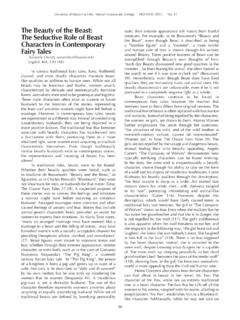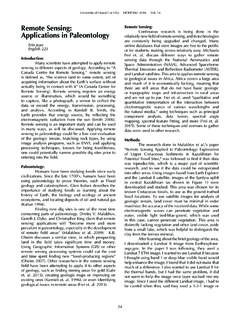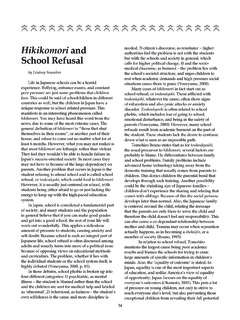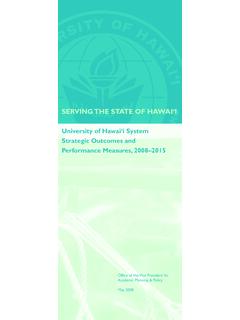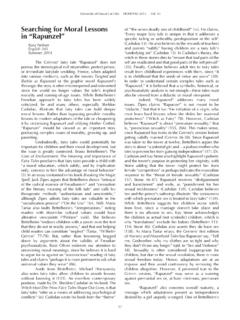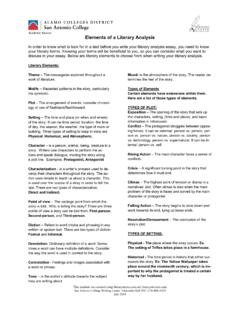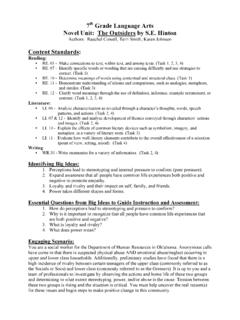Transcription of The Positive Impacts of Fairy Tales for Children
1 77 University of Hawai i at Hilo HOHONU 2016 Vol. 14 The Positive Impacts of Fairy Tales for ChildrenLeilani VisikoKnox-JohnsonEnglish 345 Children s literature helps a young child make sense of what it is to be human and helps them understand the world around them. The Fairy tale genre provides ways for Children to receive important messages. Although there are some themes in Fairy Tales that are unrealistic, the overall effect is Positive and offers fundamental elements for Children s development.
2 Based on the Jungian interpretation, Fairy Tales teach Children how to deal with basic human conflicts, desires, and relationships in a healthy way; acquiring these skills can ultimately impact a child s health, quality of life, or even influence its values and beliefs in the future. The Jungian interpretation, developed by psychotherapist Carl Jung, is a symbolic approach that creates a dialectical relationship between consciousness and the unconscious. Those who use the Jungian interpretation do not perceive therapy as a typical client-therapist relationship wherein the client is treated, but rather perceive themselves as guides to help another person delve into the unconscious.
3 Jungian therapy, also called analytical psychotherapy, treats essentially all unconscious sources such as dreams, fantasies, daydreams, even paintings and drawings. One of the central reasons that Fairy Tales are important is that they aid in child development. Fairy Tales are often shaped to test Children s initiative. Not only is reading the story essential, but having the child act out the story is also just as important for developing a child s consciousness and for his or her moral development. El koninova was interested in Children s mental development and the types of behavior they displayed when acting out a Fairy tale.
4 The experimental results from this study in Moscow drew the conclusion that a vivid enactment of an integral story plot becomes possible when a child not only intuitively understands that what happens in make-believe stories is in fact make-believe, but also believes in the reality of the story. It was found that younger Children (ages 3-4) cannot play out the part of a story completely because for them it is too real; nor are 6 7-year-olds able to do this because for them the story is too make-believe. Therefore, an integral and vivid enactment of a story occurs at about the age of five, because at this age Children are best able to establish a balance between their experience of the reality of the story and their experience of the make-believe quality of what takes place in the story and the performance when it is acted out.
5 In make-believe performances the child acquires the experience of being a subject (becoming something or someone else), which comes to him or her as an internal picture of an initiative-taking action. A child develops initiative through overcoming behavioral stereotypes and through restraining impulsive actions. Although it was concluded that Children are able to test out initiative extensively at about the age of five, this does not mean that Fairy Tales are not important before this age. In fact, the vocabulary characteristics of the semantics of a Fairy tale begin to be part of a child s play performance at around age four (El koninova 85-86).
6 These findings are important, because it provides crucial information about developing Children and how Fairy Tales are a valid part of learning, especially because there is a specific age in which Children can differentiate reality versus make-believe. Fairy Tales not only aid in child development, but they also offer a rich source of material to draw from in a therapeutic manner. This provides a great way of accessing Children s imagination by exploring memories of Fairy Tales and using them to address painful or unsettling issues in a nonthreatening, playful manner.
7 For instance, the struggle between good and evil is a frequent theme among Fairy Tales all around the world. In a therapeutic sense, this can be interpreted as internal conflict or the tension between the id and ego. Many Children and young people may suffer from internal conflict whether it is from bullying, teasing, problems at home, etc. Analyzing Fairy Tales where internal conflict is a major theme can help the therapist determine ways to help his or her client. For example, victims of abuse or neglect experience the triumph of evil over good; this is usually the other way round when it comes to Fairy Tales .
8 Enabling a young person to identify with a Fairy tale or allowing them to make up their own version could be a useful means of unlocking feelings of mistrust or guilt (Walker 81-84). This can be better appreciated through the analysis of a project titled A Fairy Tale Workshop in a Pediatric Oncology Ward. This workshop is part of a more complex intervention at a Pediatric Oncology and Hematology Ward in Naples, Italy, which provides treatment for Children suffering from cerebral neoplasia. An ill child is often unable to express his or her anxieties and ask for explanations about the situation that he or she is experiencing (Adamo 263).
9 In the Italian study, Children were offered the opportunity to get in touch safely with danger and death anxieties through the use of tale-telling. For example, The Three Little Pigs provides Children a way of exploring the solidity and resistance of the intrapsychic container; the child s own internal house (Adamo 267). In this story each pig builds a house; one made of straw, one made of sticks, and the third made of bricks. The house resembles the child s own body and the big bad wolf resembles the sickness. The ill Children experience little control, if any over their body due to their illness and this story helps them face their fears and explore their anxieties.
10 In the story, the houses made of straw and sticks are too weak to defeat the wolf. This is similar to what the Children are feeling within their own bodies; therefore they can relate their own experience to the story. 78 University of Hawai i at Hilo HOHONU 2016 Vol. 14 It is important to note that each child identifies with different characters, according to the anxieties that he or she is coping with and his or her defensive strategies. For instance, after listening to Little Red Riding Hood, Giacomo, who is three years old, imitates the wolf and draws it with its mouth wide-open.
